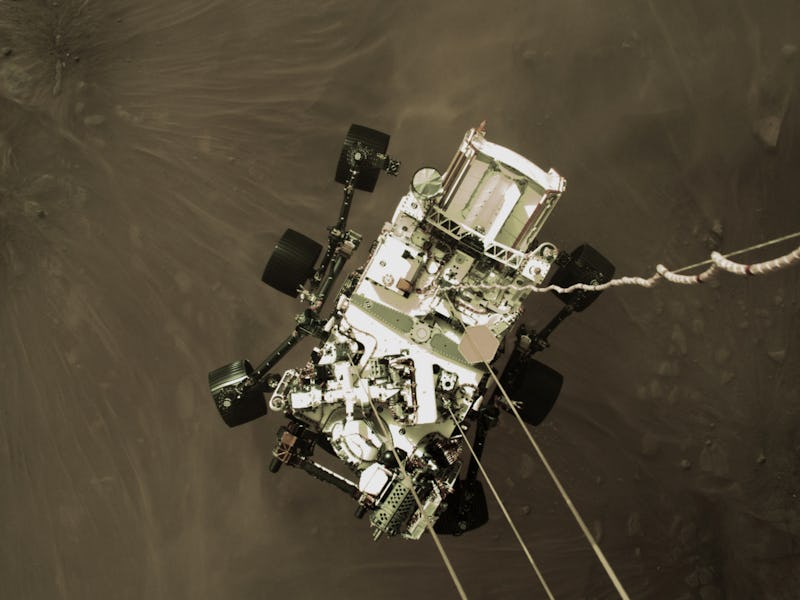NASA stumbles upon mysterious rocks hiding in ancient Martian lake
NASA's latest rover to Mars got a close look at rocks that came into contact with water.

The NASA Perseverance rover recently analyzed a trove of Martian rocks that seem oddly familiar — like where volcanic flows meet the Pacific Ocean in Hawaii, or where they meet the Atlantic Ocean in Iceland. This area, called the Séítah formation, is the scene of the newest investigation into the water that likely washed through this region billions of years ago.
Perseverance landed on Mars in February 2021. After its thrilling descent and the debut of its four-pound helicopter sidekick, Ingenuity, the mission began to explore its new home in Jezero Crater. Scientists think this 28-mile-wide feature once harbored an ancient lake. Not surprisingly, this makes the crater a prime target for those who wonder if Mars could have supported life. In addition, there’s a mystery surrounding how Jezero’s igneous rocks came about: Scientists think Séítah formed when a thick sheet of lava or a chamber of magma cooled down, but scientists don’t know what produced the molten conditions in the first place. Once cooled, the rock came into contact with a little bit of water, under conditions that might have possibly been habitable to microorganisms.
Jezero’s rocky trove appears in three new studies. Two studies are published in Science Advances (one centered around rover data from the Mastcam-Z instrument, and one about its PIXL instrument findings), and another study is published in Science (which dives into Mars’ ancient geochemistry). Among the findings, one team found the rocks might preserve biosignatures — if they’re there.
Here’s the background — Séítah is a Navajo (Diné) word meaning “amidst the sand.”
And although Mars looks dry and arid, the delta formation on the western side of Jezero suggests that a current gushed across a more moist environment than we see today.
A NASA tour of Jezero Crater’s delta on Mars.
There was some interplay between the wet and volcanic conditions. “The Séítah formation is a body of rocks that formed by cooling of either a thick sheet of lava or a chamber of magma that was still underground,” Michael Tice, geobiologist and lead author of one paper, tells Inverse. “We do not know where the lava or magma came from at the moment.”
Some rocks contain olivine, a greenish volcanic material also found on Earth. Scientists have hypothesized what created the olivine since orbital missions could identify large quantities from space. Possible explanations for its presence include melting upon a meteor impact and volcanic ash deposits.
“Olivine is a common and important mineral in the kinds of igneous rocks (basalt and gabbro) that can be found on Earth in oceanic crust and in places like Hawaii and Iceland,” says Tice.
“Olivine is interesting for many reasons, but in our case, it is important because it tends to react more quickly with water than other minerals that commonly occur with it, so it can tell us a lot about any water that has passed through a rock,” he adds.
With Perseverance, researchers learned that olivine had only been slightly altered by water, which was of a low temperature and “percolated through the crater floor,” says Tice. Even with evidence of two later water-passing stages, these phases show far less alteration to the rocks than what would be typically expected for similar rocks on Earth.
Why it matters — “Conditions in the rock during each time that water migrated through it could have supported small communities of microorganisms, and many of the new minerals that formed can preserve evidence of life,” says Tice.
But another study in the trio shows there were some nasty chemicals in Jezero’s water at some point. One group in particular, called perchlorates, are rare on Earth. Scientists found traces of this salt in olivine from a group of rocks near Séítah, called Máaz. Life as we know it would have had a hard time existing with this chemical.
What’s next — “We still do not know how that organic matter formed, but we will know a lot more when our samples arrive back on Earth,” Tice says.
The next phase of the Perseverance mission is the Mars Sample Return, where NASA and the European Space Agency will send sample-ferrying robots to the Red Planet. Its first component is tentatively scheduled to launch in 2027. If and when they bring Perseverance’s rock collection to Earth for closer analysis around the year 2033, maybe humanity will finally learn if life ever lived on the planet next door.
This article was originally published on